Reptile & Amphibian
News Blog
Keep up with news and features of interest to the reptile and amphibian community on the kingsnake.com blog. We cover breaking stories from the mainstream and scientific media, user-submitted photos and videos, and feature articles and photos by Jeff Barringer, Richard Bartlett, and other herpetologists and herpetoculturists.
Friday, January 13 2017
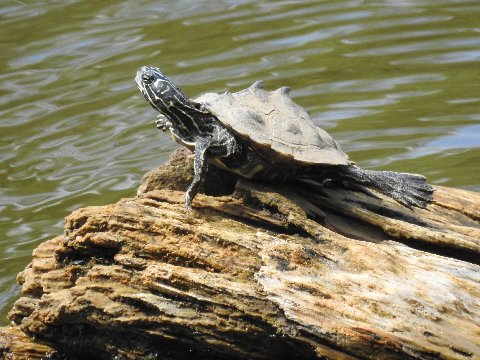
The term "sawback" fits this taxon well.
The 2 subspecies of the black-knobbed map turtle, Graptemys nigrinoda, are often referred to as the southern (or Delta) black-knob, G. n. delticola, and the northern black-knob, G. n. nigrinoda. The 2 subspecies are very similar, with the southern form being darker and having a larger plastral figure than, its better known northern cousin.
There has long been controversy regarding the validity of the Delta map as a subspecies. Some contend that it is just a clinal/environmental variation of the black-knob. Because the 2 subspecies intergrade over a large part of the range, many authorities do not even attempt to define the Delta form. But since Peter Lindeman, “Dr. Map Turtle”, saw fit to recognize the southern form in his The Map Turtle and Sawback Atlas, it was high on Jake’s and my “wannasee” list. By the way, both of these subspecies are “sawbacked” forms.
At our next stop it was the lesser known, the southern subspecies, that we hoped to see.
By the time we reached our destination a few miles north of Mobile, AL the parking lot was filled, there were dozens of boats containing happy fishermen on the oxbow, and Delta map turtles (adult size, 3-8”, females the larger) were on every exposed snag. When Jake realized that the turtles were so used to the fishermen that in very un-map- turtle-like manner they continued basking unless closely approached, he shook his head in disbelief.
It was a picture taking kind of morning!
Continue reading " Delta Map Turtle (Sawback)"
Thursday, January 12 2017

Adult female Escambia map turtles develop hypertrophied heads.
Jake and I had been talking about making a photographic foray for the various southeastern map turtles ( Graptemys) for some time. One hot day in June 2016 we decided that the time had finally come. We had motored to Florida’s western panhandle in search of a bog frog (successful), and the first map turtle on Jake’s list, the Escambia map, was just a hop, skip, and jump further westward. So we found a motel and at sunrise the next morning we began our hopping, skipping, and jumping to the Escambia River drainage, where from a fishing dock, Jake got his lifer Escambia map turtle, G. ernsti, an adult female. The turtle was well above the waterline on a distant snag, but was immediately identifiable.
Although this broad-headed map turtle had been known to exist in the Escambia, Yellow, and Shoal rivers system for years, until 1992 it had been considered the easternmost population of the Alabama map turtle. Females attain a length of 7 to 10+ inches. Males are about half that size.
Continue reading "Map Turtle Time"
Wednesday, January 11 2017
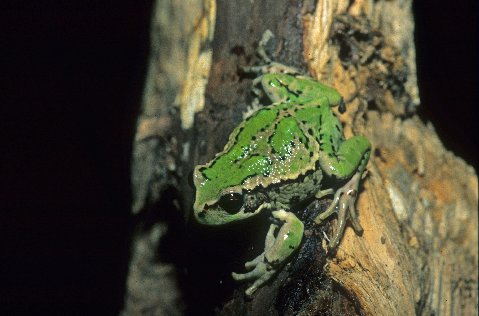
Once rather commonly seen in the pet trade, this is no longer the case with the The Rio Bamba marsupial frog, Gastrotheca riobambae.
Wayyyyyy back, from the 1950s to about 2000, importing herps for the hobby occurred at an almost unbelievable volume. Herps came to the USA from southern and eastern Africa, from many South and Central American countries, from Southeast Asia, and even from the various European countries. Within the USA itself, interstate trade in both native and imported herps was rampant and largely unregulated. When compared to today herps were abundant, species available were far more varied, and the asking prices of herps were then very cheap. For example, the 3 species of anurans pictured were once commonly seen in the American pet trade. Think back now—when was the last time you saw any of these offered? Here yesterday, gone or almost gone today. And today will soon be the yesterday when we find in future years that many of the herp taxa that we now take for granted are no longer available.
Continue reading "Forgotten Imports--Anurans"
Tuesday, January 10 2017
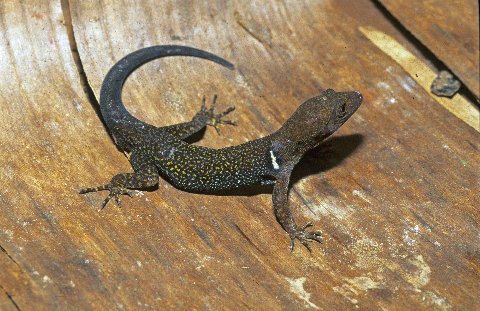
The dark outlined white shoulder marking is characteristic of the males of this taxon.
It was a female of this little (about 3” total length) lizard that I found first, and had she remained quiescent, I would have never seen her. Although the sun shown overhead, bathing the Amazonian canopy in heated brilliance, the rainforest trail that I trod was darkly shaded and relatively cool. The lizard, herself dark except for a single white tailtip band, was also on a dark, mouldering treetrunk. But for the nervously waving tail she. A collared gecko, Gonatodes concinnatus, was nearly invisible. But even in the gloom of the rainforest that seemingly disembodied patch of white waving to and fro caught my attention. I readied the camera but she darted to one side to never be seen by me. About 20 feet further on the trail and I happened across another female of this diurnal gecko wagging her strongly patterned tail. This time I got a picture.
But it was not until the next trip that I had an opportunity to see a male of this beautiful lizard. In fact, I got to see 2 males. The first was brought to me by a villager who had caught the lizard and secured it in a small plastic bag. I was delighted at having the opportunity to carefully observe the lizard. But I was even happier when later that day I was walking by the bird observation platform and I saw another male, this one perched quietly on a large bracket fungus. Camera…
Continue reading "The Collared Forest Gecko"
Monday, January 9 2017
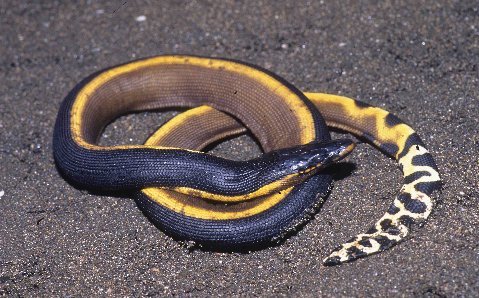
Although caudal patterns may vary, elsewhere the colors are pretty well standardized.
We rented a tiny boat, a motor, and a driver, on the docks of a small fishing village on Costa Rica’s Pacific coast. Cost had been negotiated successfully, and within a few minutes we were on our way westward on the choppy waters of the bay. Our target species on this watery interlude was the yellow-bellied sea snake, Pelamis platurus, which species was quite common in the region, but that was most commonly seen by fishermen in the ocean slicks, patches of smooth-surfaced water that drifted between the choppy surfaces and when the snake became stranded on the beach.
Although Pelamis grows to nearly 4’ in length, those that we saw ranged from 24 to about 32 inches. On that trip we saw more than 2 dozen of these pelagic serpents. And indeed they are pelagic, ranging from the Asiatic shores of the Indian and Pacific oceans, Africa, and in the New World from Central America to California (rare in the USA). It has also been found far asea. Although this has often been said to be the most widely distributed of the world’s snakes, I’m wondering if the tiny flowerpot (blind) snake is not now a close runner-up?
Male Pelamis tend to be the smaller. This is a fish eating species.
Continue reading "Yellow-bellied Sea Snakes"
Friday, January 6 2017
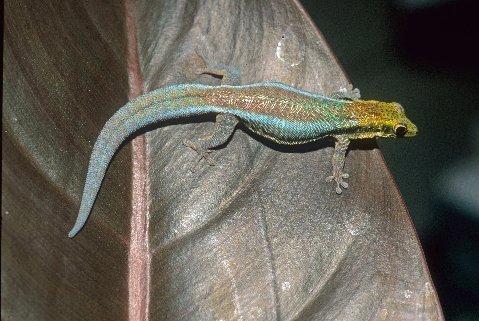
This is a gravid female neon day gecko.
When I first saw a Phelsuma klemmeri at Glades Herp I exclaimed to Rob “that thing is brighter than a neon tetra!” And “neon day gecko” was the name that caught on for this yellow headed, blue and green, flattened, 3 ½ inch long mini-beauty.
Despite their small size I have found this small gecko to be easily kept and bred. Although a pair can easily thrive in a 12” cubed reptile cage, mine are in 24 x24x12” terraria. In a well-planted terrarium this size I am able to keep 2.4 of the geckos without fear of serious aggression. Since Epipremnum aureus is a hardy and pretty aroid that provides both humidity and substantial cover for the lizards, this is the planting I most often use. Lengths of bamboo (both vertical and diagonal (*see additional caging comments below)), heat and light are provided on both ends of the tank, thereby allowing the lizards ample room to stay well separated.
There is little question that the males of neon day geckos are territorial, but fewer keepers realize that to a lesser degree the females are also. Little serious physical harm comes from adverse interactions but the stress of persecution may eventually take its toll on the subordinate inhabitants. In a large communal situation, by providing well separated areas of equally ideal habitat, adverse effects from territoriality can be almost eliminated. In a smaller enclosure only a single pair should be kept.
Caging-Feeding suggestions
· Full spectrum lighting and a tight fitting screen top is necessary for this diurnal taxon
· 1/8” crickets, dusted with D3 + calcium as well as a prepared phelsuma diet should be provided
· Ascertain aggression does not occur. Do not crowd.
· Gently mist the terrarium daily. DO NOT overwet.
· 76-80F nights, 84-88F days.
· Vertical or diagonal dry bamboo sections between 1 and 3 inch diameter and as tall as the tank, preferably with natural longitudinal cracks through which the geckos may easily move, should be provided. Gravid female may need a marginally wider than normal opening. Careful use of a circular saw can provide access openings if natural cracks are not present.
· Sit back, relax, and enjoy these wonderful lizards!
Continue reading "Neon Day Gecko"
Thursday, January 5 2017
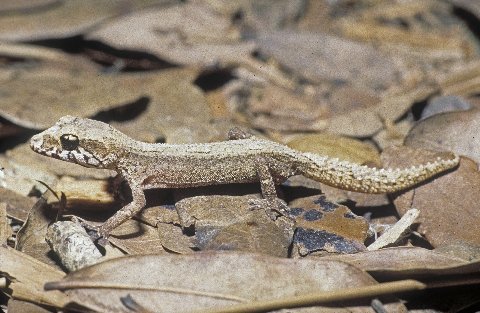
The earthen colors blend well with the litter of the forest floor.
Clad in roughened scales of muted browns, tans, grays, white, and charcoal, the little Paraoedura androyensis, pygmy panther gecko, is well suited to life in the leaf litter of the southern and eastern Malagasy deciduous forests. This is the smallest of the 13 (with only one species being extralimital to Madagascar) species in this genus, with females, the marginally larger gender, attaining a total length a bit in excess of 3”. When the gecko is moving about, the tail, shorter than the snout-vent length, is often curled over the body. Dorsally the tail bears numerous conical scales and is studded with large, more rounded, scales ventrally.
This is an easy gecko to maintain. It usually feeds readily and will thrive in a leaf covered, clean soil, substrate at 79 to 88 degrees.They will drink from a shallow water dish but will benefit and will drink droplets when their cage is gently misted. Full spectrum lighting is not necessary for this nocturnal gecko.
Never particularly common is the pet trade, this panther gecko is even less so today than just 10 years ago. Fortunately there are a few breeders that occasionally offer captive bred individuals and a very few wild caught examples are usually available each year.
If you’re thinking of acquiring a pair of geckos, think this species. It is a species that is well worth working with.
Continue reading "Androy Pygmy Panther Gecko"
Wednesday, January 4 2017
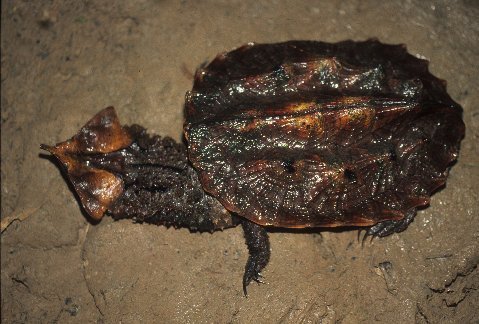
Matamatas are always difficult to find and a pleasure to see.
I’m probably crossing some line or the other here by mentioning one of these 3 taxa but I’ll have a go at it anyway. The three species—wondrous Amazonians all-- that I have firmly in mind are the matamata, Chelus fimbriatus, the Suriname toad, Pipa pipa, and the Amazonian leaf fish, Monocirrhus polyacanthus, ambush predators all and all amazingly camouflaged aquatic predators.
The matamata grows to 18”, is flattened, and is camouflaged both by its mud color and skin flanges. It is a fish eater that catches prey by extending its head rapidly forward while distending its throat. The resulting vacuum draws an unwary fish into the mouth where it is then quickly swallowed.
The 6” long Suriname toad, primarily an invertebrate eater that will accept small fish, is also camouflaged by color and its flattened appearance. Rather than catching prey like a roving vacuum, this anuran shovels edible items into its wide mouth with its forefeet and fingers.
At 3”, the leaf fish is by far the smallest of these 3 predatory species, and limits itself, at least when adult, to a diet of smaller fish. The mouth of the leaf fish is large, distensible and extendable and a single barbel, in appearance like the stem of a leaf, extends from the lower jaw. Camouflaged by color and a very slow head down approach, this little mud colored (sounds like a broken record doesn’t it?) fish is a hunter to be reckoned with.
Do I see all 3 on every trip? No. But sometimes I do get lucky.
Continue reading "Three Wondrous Amazonians"
Tuesday, January 3 2017
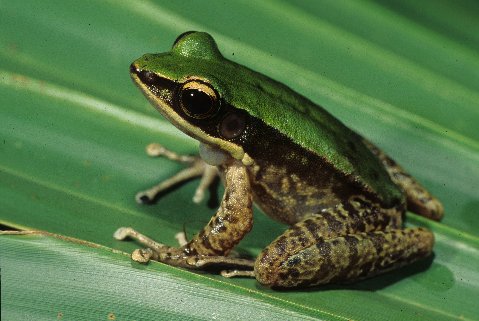
Pretty and very agile, the green cascades frog was imported from Hong Kong.Prior to the turn of the century, occasional herp shipments from Southeast Asia (and most notably from Hong Kong) would include a few interesting anurans. One that I found very interesting was the beautiful and agile green cascades frog. Although imported under the name of Rana livida it was even then recognized that rather than an actual species, the cascades frogs were actually a species complex. Over the years genetic assessment has identified at least 6 additional lookalike species and the Hong Kong form (with which I was familiar) is now recognized as Odorrana chloronota. ( Odorrana livida is now known to be restricted to southern Myanmar.)
As indicated by its common name this is a stream dwelling species, but not indicated by its name is the fact that the waters in which this primarily nocturnal frog occurs are not necessarily cascades. Within the streams the green cascades frog may be seen on boulders, logs, and the stream banks. This species is sexually dimorphic with females attaining a snout-vent length of 5” and adult males being about half that length.
Continue reading "Green Cascades Frog"
Monday, January 2 2017
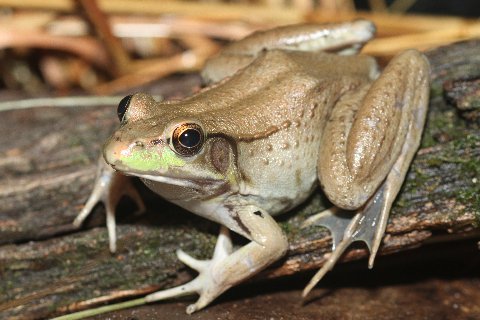
A bronze frog, Rana c. clamitans
The controversial generic name of Lithobates has been laid to rest—at least for Holarctic frog taxa.
Holarctic? What, exactly, does that mean and what frog species does it encompass?
Meriam Webster dictionary defines the term Holarctic thusly: “of, relating to, or being the biogeographic region including the northern parts of the Old and the New Worlds and comprising the Nearctic and Palearctic regions or subregions”. Or defined by the Free Dictionary as “a floristic and zoogeographic land area that occupies the extratropical portion of the northern hemisphere; its southern boundary lies roughly along the northern boundary of the Tropic of Cancer”.
In a Facebook post, geneticist David Hillis states “Our paper on the systematics and biogeography of Rana (Holarctic true frogs) is now available as a pdf at this link (final volume and page numbers to come): http://sysbio.oxfordjournals.org/cgi/reprint/syw055.
The actual name of the paper is Spatiotemporal Diversification of the True Frogs (Genus Rana): A Historical Framework for a Widely Studied Group of Model Organisms and Dr. Hillis was one of the 15 authors.
With this paper Lithobates is gone and Rana is back! To Dr. Hillis and the 14 coauthors I extend my profound “thanks.”
Continue reading "A Return to Rana"
|



